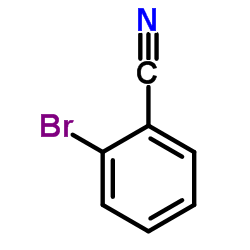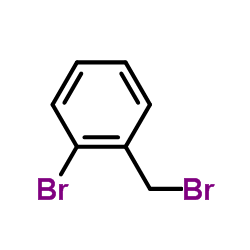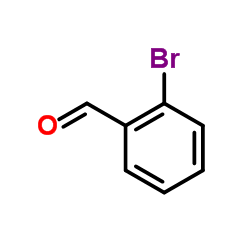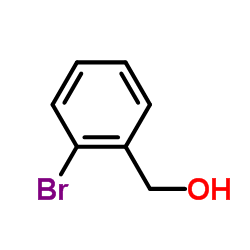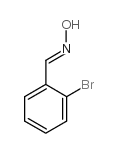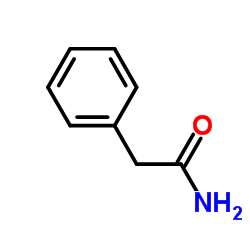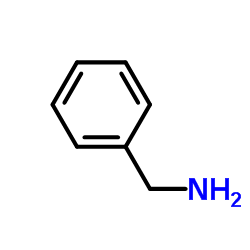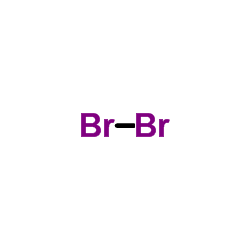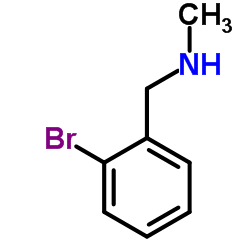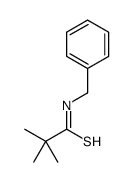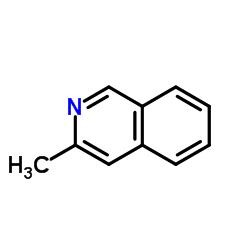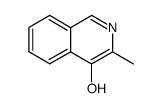3959-05-5
| 中文名 | 2-溴苄胺 |
|---|---|
| 英文名 | 2-Bromobenzylamine |
| 中文别名 |
邻溴苄胺
2-溴苯甲胺 |
| 英文别名 |
MFCD00025572
1-(2-Bromophenyl)methanamine (2-bromophenyl)methanamine Benzenemethanamine, 2-bromo- |
| 密度 | 1.5±0.1 g/cm3 |
|---|---|
| 沸点 | 243.5±15.0 °C at 760 mmHg |
| 分子式 | C7H8BrN |
| 分子量 | 186.049 |
| 闪点 | 101.0±20.4 °C |
| 精确质量 | 184.984009 |
| PSA | 26.02000 |
| LogP | 1.86 |
| 外观性状 | 无色 液体 |
| 蒸汽压 | 0.0±0.5 mmHg at 25°C |
| 折射率 | 1.590 |
| 储存条件 | 常温,避光,通风干燥处,密封保存 |
| 稳定性 | 常温常压下稳定 |
| 分子结构 | 1、摩尔折射率:42.39 2、摩尔体积(cm3/mol):125.6 3、等张比容(90.2K):323.6 4、表面张力(dyne/cm):44 5、介电常数:无可用的 6、极化率(10-24cm3):16.8 7、单一同位素质量:184.984004Da 8、标称质量:185Da 9、平均质量:186.0491Da |
Synonym:None Known Section 2 - COMPOSITION, INFORMATION ON INGREDIENTS
Risk Phrases: 34 Section 3 - HAZARDS IDENTIFICATION EMERGENCY OVERVIEW
Causes burns.Corrosive. Potential Health Effects Eye: Causes eye burns. May cause chemical conjunctivitis and corneal damage. Skin: Causes skin burns. May cause skin rash (in milder cases), and cold and clammy skin with cyanosis or pale color. Ingestion: May cause severe and permanent damage to the digestive tract. Causes gastrointestinal tract burns. May cause perforation of the digestive tract. May cause systemic effects. Inhalation: Causes chemical burns to the respiratory tract. Aspiration may lead to pulmonary edema. May cause systemic effects. Chronic: Effects may be delayed. Section 4 - FIRST AID MEASURES Eyes: Get medical aid immediately. Do NOT allow victim to rub eyes or keep eyes closed. Extensive irrigation with water is required (at least 30 minutes). Skin: Get medical aid immediately. Immediately flush skin with plenty of water for at least 15 minutes while removing contaminated clothing and shoes. Wash clothing before reuse. Destroy contaminated shoes. Ingestion: Never give anything by mouth to an unconscious person. Get medical aid immediately. Do NOT induce vomiting. If conscious and alert, rinse mouth and drink 2-4 cupfuls of milk or water. Inhalation: Get medical aid immediately. Remove from exposure and move to fresh air immediately. If breathing is difficult, give oxygen. Do NOT use mouth-to-mouth resuscitation. If breathing has ceased apply artificial respiration using oxygen and a suitable mechanical device such as a bag and a mask. Notes to Physician: Treat symptomatically and supportively. Section 5 - FIRE FIGHTING MEASURES General Information: As in any fire, wear a self-contained breathing apparatus in pressure-demand, MSHA/NIOSH (approved or equivalent), and full protective gear. During a fire, irritating and highly toxic gases may be generated by thermal decomposition or combustion. Extinguishing Media: Use water spray, dry chemical, carbon dioxide, or chemical foam. Section 6 - ACCIDENTAL RELEASE MEASURES General Information: Use proper personal protective equipment as indicated in Section 8. Spills/Leaks: Absorb spill with inert material (e.g. vermiculite, sand or earth), then place in suitable container. Avoid runoff into storm sewers and ditches which lead to waterways. Clean up spills immediately, observing precautions in the Protective Equipment section. Provide ventilation. Section 7 - HANDLING and STORAGE Handling: Do not breathe dust, vapor, mist, or gas. Do not get in eyes, on skin, or on clothing. Keep container tightly closed. Do not ingest or inhale. Use only in a chemical fume hood. Discard contaminated shoes. Storage: Store in a cool, dry place. Store in a tightly closed container. Corrosives area. Section 8 - EXPOSURE CONTROLS, PERSONAL PROTECTION Engineering Controls: Facilities storing or utilizing this material should be equipped with an eyewash facility and a safety shower. Use adequate ventilation to keep airborne concentrations low. Exposure Limits CAS# 3959-05-5: Personal Protective Equipment Eyes: Wear appropriate protective eyeglasses or chemical safety goggles as described by OSHA's eye and face protection regulations in 29 CFR 1910.133 or European Standard EN166. Skin: Wear appropriate protective gloves to prevent skin exposure. Clothing: Wear appropriate protective clothing to prevent skin exposure. Respirators: Follow the OSHA respirator regulations found in 29 CFR 1910.134 or European Standard EN 149. Use a NIOSH/MSHA or European Standard EN 149 approved respirator if exposure limits are exceeded or if irritation or other symptoms are experienced. Section 9 - PHYSICAL AND CHEMICAL PROPERTIES Physical State: Liquid Color: Not available. Odor: Not available. pH: Not available. Vapor Pressure: Not available. Viscosity: Not available. Boiling Point: Not available. Freezing/Melting Point: Not available. Autoignition Temperature: Not available. Flash Point: Not available. Explosion Limits, lower: Not available. Explosion Limits, upper: Not available. Decomposition Temperature: Solubility in water: Specific Gravity/Density: Molecular Formula: C7H8BrN Molecular Weight: 186.05 Section 10 - STABILITY AND REACTIVITY Chemical Stability: Not currently available. Conditions to Avoid: None reported. Incompatibilities with Other Materials: Oxidizing agents. Hazardous Decomposition Products: Nitrogen oxides, carbon monoxide, carbon dioxide, hydrogen bromide. Hazardous Polymerization: Has not been reported Section 11 - TOXICOLOGICAL INFORMATION RTECS#: CAS# 3959-05-5 unlisted. LD50/LC50: Not available. Carcinogenicity: 2-Bromobenzylamine - Not listed by ACGIH, IARC, or NTP. Section 12 - ECOLOGICAL INFORMATION Ecotoxicity: Fish: Pseudomonas putida: Section 13 - DISPOSAL CONSIDERATIONS Dispose of in a manner consistent with federal, state, and local regulations. Section 14 - TRANSPORT INFORMATION IATA Shipping Name: AMINES, LIQUID, CORROSIVE, N.O.S. Hazard Class: 8 UN Number: 2735 Packing Group: III IMO Shipping Name: AMINES, LIQUID, CORROSIVE, N.O.S. Hazard Class: 8 UN Number: 2735 Packing Group: III RID/ADR Shipping Name: AMINES, LIQUID, CORROSIVE, N.O.S. Hazard Class: 8 UN Number: 2735 Packing group: Section 15 - REGULATORY INFORMATION European/International Regulations European Labeling in Accordance with EC Directives Hazard Symbols: C Risk Phrases: R 34 Causes burns. Safety Phrases: S 26 In case of contact with eyes, rinse immediately with plenty of water and seek medical advice. S 36/37/39 Wear suitable protective clothing, gloves and eye/face protection. S 45 In case of accident or if you feel unwell, seek medical advice immediately (show the label where possible). WGK (Water Danger/Protection) CAS# 3959-05-5: No information available. Canada None of the chemicals in this product are listed on the DSL/NDSL list. CAS# 3959-05-5 is not listed on Canada's Ingredient Disclosure List. US FEDERAL TSCA CAS# 3959-05-5 is not listed on the TSCA inventory. It is for research and development use only. SECTION 16 - ADDITIONAL INFORMATION N/A |
|
生态学数据: 通常对水是不危害的,若无政府许可,勿将材料排入周围环境。
|
| 危害码 (欧洲) | C:Corrosive; |
|---|---|
| 风险声明 (欧洲) | R21/22;R34 |
| 安全声明 (欧洲) | S45-S36/37/39-S26 |
| 危险品运输编码 | UN2735 |
| 包装等级 | III |
| 危险类别 | 8 |
| 海关编码 | 2921499090 |
|
~94% 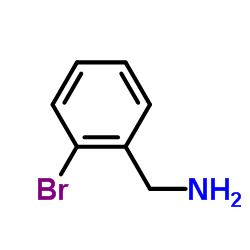
3959-05-5 |
| 文献:Nabid, Mohammad Reza; Bide, Yasamin; Niknezhad, Mahvash ChemCatChem, 2014 , vol. 6, # 2 p. 538 - 546 |
|
~% 
3959-05-5 |
| 文献:American Chemical Journal, , vol. 2, p. 317,319 |
|
~93% 
3959-05-5 |
| 文献:Prakasha, Kothathi C.; Sindhumol, Methatta; Ramesha Baba; Channe Gowda Journal of Chemical Research, 2007 , # 5 p. 284 - 286 |
|
~% 
3959-05-5 |
| 文献:Organic Letters, , vol. 16, # 2 p. 484 - 487 |
|
~% 
3959-05-5 |
| 文献:Organic Letters, , vol. 16, # 2 p. 484 - 487 |
|
~% 
3959-05-5 |
| 文献:Journal of Organometallic Chemistry, , vol. 281, p. 389 - 396 |
|
~% 
3959-05-5 |
| 文献:Chemische Berichte, , vol. 18, p. 2736 |
|
~% 
3959-05-5 |
| 文献:Chemische Berichte, , vol. 18, p. 2938 |
| 上游产品 8 | |
|---|---|
| 下游产品 10 | |
| 海关编码 | 2921499090 |
|---|---|
| 中文概述 | 2921499090 其他芳香单胺及衍生物及它们的盐. 增值税率:17.0% 退税率:9.0% 监管条件:无 最惠国关税:6.5% 普通关税:30.0% |
| 申报要素 | 品名, 成分含量, 用途 |
| Summary | 2921499090 other aromatic monoamines and their derivatives; salts thereof VAT:17.0% Tax rebate rate:9.0% Supervision conditions:none MFN tariff:6.5% General tariff:30.0% |


